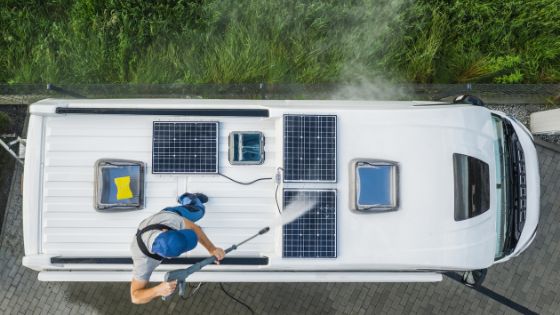Solar power has many applications in the modern world and has been used to power just about everything from small cabins to large commercial buildings. However, there are few applications where solar power is as convenient as it is when added to an RV. RVs already allow you to bring the comforts of home around with you pretty much everywhere, but they do have one significant limitation—you’ll need to be able to hook up to shore power.


Adding solar to your RV removes this limitation and opens up many more options for your travel and camping locations. Keep reading to learn what components you’ll need to build an RV solar system.
Battery Bank
A battery bank is key to an RV solar system, as it is what keeps your appliances running when there is no sun for active solar energy usage. Battery banks allow you to store the solar power you generate during the day for later use. In a home, the building could switch to grid power; but if you’re RVing away from a traditional campsite and don’t have shore power, your RV will go dark.
It’s incredibly important that your battery bank is appropriately sized—and sizing, in this case, has nothing to do with physical space at all. When it comes to solar products, “size” refers to the amount of energy a piece of equipment can make or store. You’ll want a battery bank capable of storing more than enough energy to get you through the night until the sun comes up and recharges your batteries. This requires some careful calculations but ultimately means adding up the energy consumption of every appliance you use and how long you use it for.
Solar Panels
Naturally, you can’t have a solar system without solar panels. These sit on your RV’s roof and collect sunlight, converting it into electricity. On an RV, panels can be mounted flat against the roof, or you can opt for a racking system that slightly tilts the panels. Both methods have pros and cons, so consult with a specialist to determine which option is best for you.
Inverter
Many of the devices you’ll run in your RV can use DC power that’s created by your panels and stored in your batteries. However, many appliances will rely on AC power, and to use those appliances, you’ll need an inverter. This device converts the DC power to AC power so that you can use all the electrical devices in your RV.
Charge Controller
The charge controller stands between your solar panels and your battery bank, helping to control the rate at which the batteries charge. Without this piece of equipment, you risk overcharging your batteries and damaging them, so don’t skimp out on this component. You may also be able to find an RV inverter that has a charge controller built into it.

























